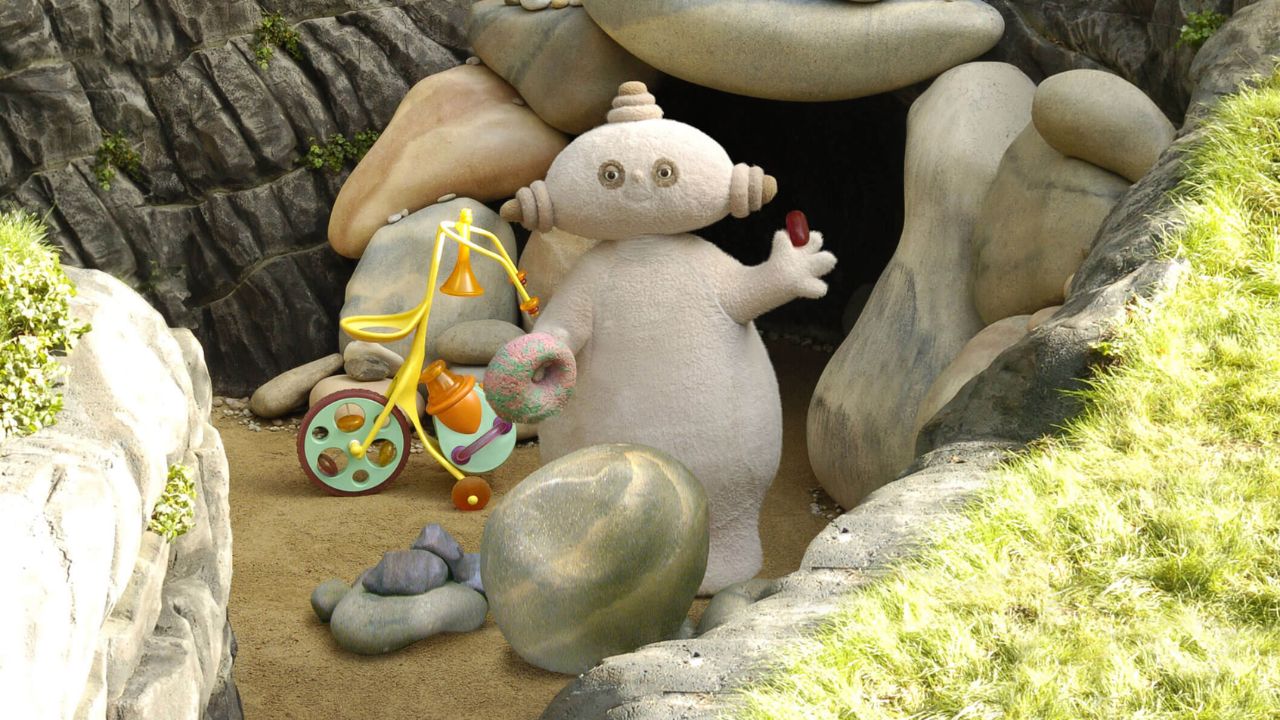Makka Pakka is more than just a cute figure in a preschool show. He’s a warm, gentle character who’s been a part of early childhood entertainment for over a decade. Children around the world know his round shape, cheerful hum, and love for washing stones. Behind that simple image lies a carefully crafted world built with imagination, storytelling, and technical mastery. This article takes you deep into Makka Pakka’s story, his role in In the Night Garden, and the real-world production details that make him so special.
Who Is Makka Pakka?
Makka Pakka is one of the central characters in In the Night Garden, a BBC children’s television series designed for preschoolers. He lives in a small cave at the edge of the magical forest, a calm corner of the Night Garden world. His daily routine is simple yet soothing—he collects, cleans, and stacks small stones with the help of his Og-Pog vehicle.
This gentle, round-faced creature represents comfort and stability for many children. His repetitive actions mirror bedtime rituals, giving young viewers a sense of safety and familiarity. Unlike louder or more energetic Night Garden characters like Igglepiggle or Upsy Daisy, Makka Pakka speaks softly and moves slowly, embodying calmness.
“Makka Pakka’s presence is like a bedtime lullaby brought to life.” — Guardian interview with Andrew Davenport
Makka Pakka’s Traits
- Kind-hearted: Always helps others and keeps things clean.
- Routine-driven: Cleans stones every day and interacts with friends in predictable ways.
- Visually iconic: Round body, beige color, and trumpet-like voice.
- Educational role: Teaches children the value of routine, tidiness, and friendship.
Iconic Tools and Props: The Og-Pog and More
If Makka Pakka is the heart of this British preschool series, then his Og-Pog vehicle is his trusted sidekick. It’s a small, wheeled cart filled with tools that define his daily activities. These tools aren’t just props—they’re teaching aids wrapped in whimsy.
| Prop | Function | Symbolism |
| Og-Pog vehicle | Carries his tools and stones | Routine, independence |
| Makka Pakka trumpet | Makes his signature sound | Communication, character identity |
| Sponge & soap | Used for washing stones | Cleanliness, care |
| Uff-uff dryer | Dries stones after cleaning | Order, completion |
These objects help children associate simple tasks with joy. Just like a child’s favorite blanket or toy, the Og-Pog represents security and comfort. It also makes Makka Pakka one of the most easily recognizable children’s TV show characters in modern media.
Friends and Relationships in the Night Garden
Makka Pakka may be a solitary figure at times, but he isn’t alone in the Night Garden world. His friendships define many of the show’s most memorable moments.
Key Relationships
- Igglepiggle: One of his closest friends, often sharing quiet adventures.
- Upsy Daisy: Brings energy and contrast to Makka Pakka’s calm.
- Tombliboos: Often found playing and exploring together.
- Pontipines and Wottingers: Represent the community spirit of the Garden.
Their interactions are gentle, filled with repetition and song. These scenes mimic the way children socialize—through simple gestures, shared activities, and friendly routines. For example, when Makka Pakka washes Igglepiggle’s face, it reflects acts of care familiar to bedtime rituals.
“The Night Garden characters aren’t just fictional friends; they mirror the emotional landscape of early childhood.”
Setting the Scene – The Magical Night Garden
The setting of In the Night Garden is as iconic as its characters. The magical forest with its bright colors, inflatable structures, and gentle music box theme creates an environment children instantly recognize.
This fantasy storytelling space was filmed at Smatchley Wood, a private woodland in Warwickshire, Britain. It’s a real location transformed into a dreamlike landscape with green screen techniques, chroma key sets, and hand-crafted props. This setting merges real-world natural beauty with imaginative design, giving the series its distinctive look.
Key features of the Night Garden include:
- Ninky Nonk – a whimsical train weaving through the forest
- Pinky Ponk – an airship floating gently above the trees
- Magical gazebo – where bedtime stories unfold
- Tittifers – singing birds that signal the end of each episode
This environment feels safe and inviting, echoing the feeling of a child’s dream.
Behind the Scenes – How the Show Was Made
The production of In the Night Garden was a technical achievement for children’s television. It combined live action, stop motion animation, puppetry, and CGI animation to create a layered, immersive world.
| Production Element | Details |
| Production company | Ragdoll Productions, BBC Worldwide |
| Creator | Andrew Davenport |
| Narrator | Derek Jacobi |
| Filming location | Smatchley Wood, Warwickshire, UK |
| Episode cost | Approximately £145,000 per episode |
| Visual effects | Adobe Illustrator, Adobe Animate, chroma key |
| Filming techniques | Puppetry, costume acting, green screen |
The show’s team built hundreds of props—giant daisies, inflatable Haahoos, and colorful stones. These objects, combined with expert lighting, created the illusion of a living, breathing magical world.
Actors in costume performed on set while animators added finishing touches. This hybrid technique was unusual for a preschool program at the time and helped set a new standard for BBC children’s television.
The Creative Minds Behind Makka Pakka
Every great character has a story behind the scenes. Makka Pakka was brought to life by Andrew Davenport, who also co-created Teletubbies. Davenport once shared in a Guardian interview that he designed the Night Garden characters based on “the world as seen through a child’s half-asleep mind.”
Ragdoll Productions and BBC Worldwide produced the series, ensuring high quality and wide global reach. The voice that ties the series together belongs to Derek Jacobi, whose narration gives the show its soft, rhythmic flow.
Makka Pakka’s rounded design and predictable actions weren’t accidents. They were built on early childhood development research showing that children respond well to repetition, round shapes, and clear facial expressions. This careful attention to detail explains why Makka Pakka still resonates with audiences today.
Educational Themes and Storytelling Style
In the Night Garden isn’t just entertainment—it’s a structured, developmental tool. Each episode follows a consistent bedtime storytelling rhythm that mimics children’s evening routines.
Core Educational Themes
- Routine and predictability: Makka Pakka’s stone-washing mirrors daily habits like brushing teeth or taking a bath.
- Gentle storytelling: The slow pace encourages calmness before sleep.
- Language development: Repeated phrases and sounds support early speech learning.
- Emotional security: Familiar faces and routines help reduce bedtime anxiety.
The show often opens with the night sky and stars, then transitions to Igglepiggle traveling to the Garden. At the end, the Tittifers sing, signaling it’s time for everyone to sleep. This structure is both comforting and educational, giving young viewers a clear sense of sequence.
“When Makka Pakka cleans stones, children learn that small, repeated actions can be both calming and meaningful.”
Common Myths and Online Hoaxes
In recent years, bizarre internet stories have surfaced claiming Makka Pakka death events, NGPD arrests, and even Pinky Ponk chases involving fictional drug bust parodies. These stories include absurd claims like “Arrest of Makka Pakka” or “Makka Pakka held without bail.”
It’s important to be clear:
- These are fictional scandals created as internet satire.
- No such events exist in the actual children’s program.
- References to NGPD (Night Garden Police Department) or NYPD in this context are entirely made up.
Makka Pakka remains a wholesome children’s character. However, these parodies highlight how nostalgic shows can sometimes be twisted into meme culture. Parents should rely on trusted sources like BBC and Ragdoll Productions for accurate information.
Lasting Legacy and Cultural Impact
When In the Night Garden premiered, it changed how preschool media was made. Its soft visuals, bright colors and music, and gentle routines connected with children globally. Over time, Makka Pakka became one of the most recognized figures in preschool entertainment.
Cultural Impact at a Glance
| Aspect | Details |
| First broadcast | 19 March 2007 |
| Total episodes | 100 |
| Target age | 1–6 years old |
| Broadcast reach | Over 35 countries worldwide |
| Live shows and tours | Ongoing across the UK and internationally |
| Merchandising | Plush toys, storybooks, Ninky Nonk and Pinky Ponk playsets, clothing |
Fans who grew up watching Makka Pakka often pass the show on to their children. Live shows continue to draw families, and merchandise remains popular. This lasting presence speaks volumes about the power of gentle storytelling and timeless design.
Final Thoughts on Makka Pakka’s Enduring Charm
Makka Pakka stands as proof that the simplest characters can leave the biggest impact. His world—a magical forest filled with soft sounds, warm colors, and kind friends—has comforted millions of children as they drift to sleep. Unlike many fast-paced modern kids’ programs, In the Night Garden remains calm, rhythmic, and emotionally safe.
His Og-Pog vehicle, the songs, the trumpet, and his friends like Igglepiggle and Upsy Daisy remind us that joy often lives in small, repetitive rituals. Whether through stop motion animation, puppetry, or creative design, the team behind this BBC children’s television classic built a timeless space where imagination gently meets reality.

